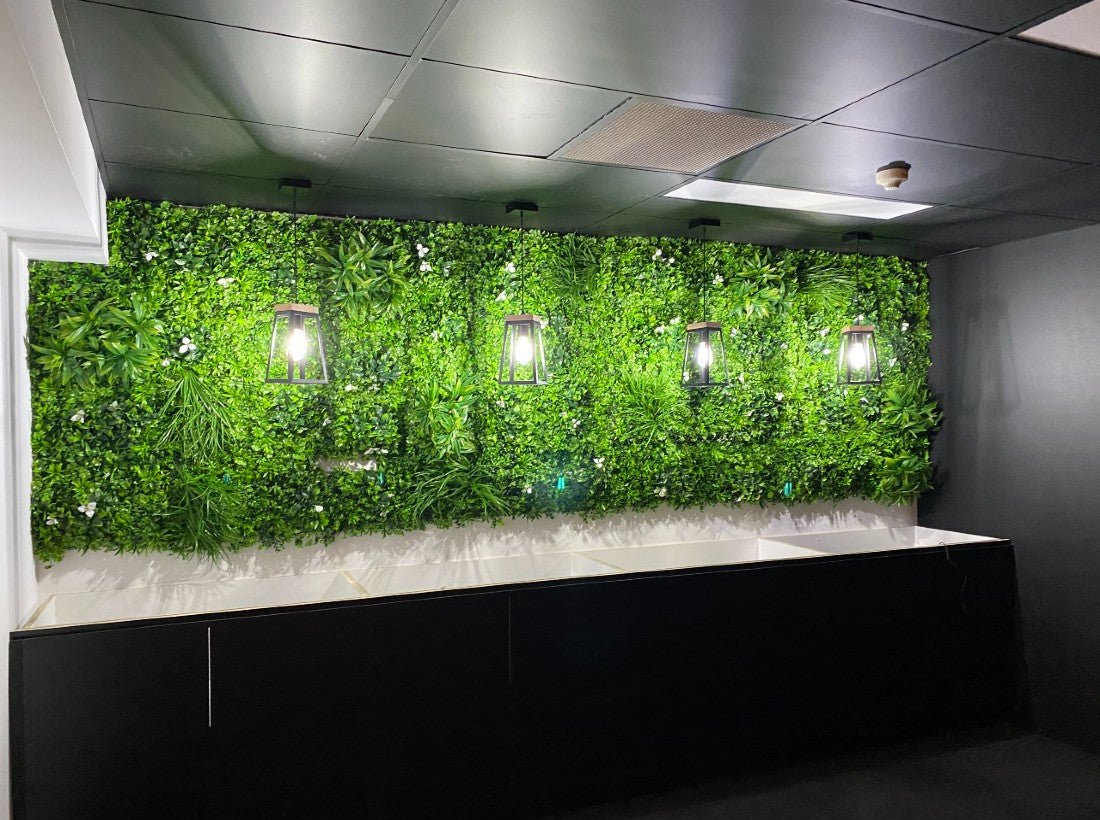No green thumb. Gasp.
A short expression that brings about a waterfall of missed opportunities and sadness. Until you realize that your very own Garden of Eden doesn’t just have to be a distant dream.
Following the recent popularity boom of bringing greenery into homes, more and more people have begun creating artificial indoor gardens. And it’s not hard to see why, as the minimal maintenance and no need for sunlight and watering appeals to even the busiest Americans.
But just because it’s easy to maintain doesn’t mean there’s no room for mistakes. Below, you’ll find some of the most common (and detrimental) blunders that muddle the beauty of your indoor oasis and twist it into a cluttered, unsightly mess.
9 Most Common Mistakes With Artificial Indoor Gardens
Before you begin trekking the delightful journey of greenifying your home, you should have a plan in mind. If you don’t, you’ll most likely hit a curb by making some of these missteps:
Using Low-Quality Fake Plants

Cheap, plasticky fake greenery will detract from the aesthetic of your artificial indoor garden and will ruin the beauty you’ve worked hard to attain. That’s why investing in high-quality faux plants made from sustainable materials will be a game changer and make a big difference in the appearance and longevity of your indoor garden.
When you focus on quality, you won’t have to worry about replacing your fake plants anytime soon. Plus, your friends won’t be able to tell your garden isn’t a chunk of Mother Nature herself since each product is perfect in its imperfection, just like natural foliage!
Decorating With Just Plants

But wait, aren’t plants the main feature of an indoor garden? They’re undoubtedly the main one, but they shouldn’t be the only one. If you don’t want your fake indoor garden to resemble an untamed jungle, incorporate other elements, such as:
- Decorative rocks
- Art pieces
- Water features
- Small sculptures
- Lighting
- Knickknacks
- Moss
- Pieces of wood
All of these items add variety, break up the monotony in your indoor garden, and make the space more visually interesting. After all, looking at a blob of green isn’t particularly enticing, is it?
Cluttering Your Indoor Garden
On the other hand, you shouldn’t weigh down your garden with a lot of décor either because then it wouldn’t be a garden anymore. There should always be more plants than items and each decoration should be placed intentionally and contribute to a harmonious ambiance. Assuming you want to mimic the look of a real garden, be sparse with your decorative items and mindful of where you place them.
If you want to or already have a focal point in your artificial indoor garden, make sure it’s a faux plant and not a sculpture or an art piece.
Paying No Attention to the Placement

Although you’re dealing with artificial greenery, it’s still in your best interest to place your fauxliege in a good location. Faux plants and green walls don’t need light to thrive, but if you set them in a dark corner, they’ll look unnatural and out of place. If you’re not sure how to best arrange them, think of where you would plant living plants and follow that model.
It’s true that fake indoor gardens don’t demand sunlight. But it’s also true that you should keep them close to windows to paint a prettier picture and benefit from what visitors would expect to see. Just remember not to prop them up in direct sunlight because it’ll make them fade quickly.
Skipping Repotting
Don’t worry, we didn’t forget that we’re talking about artificial plants. But taking your new faux plants out of their original planters and repotting them into decorative ones will help you achieve unparalleled coordination and order. A tastefully plant-studded home takes into account how each addition fits within the bigger picture and how you can increase or decrease the prominence of every element.
For example, if you want to bring a plant out and draw attention to it, you can place it in an intricate planter and on a tall stand so it catches the eye.
Overlooking the Background
Arranging artificial plants around the space without any regard for the backdrop can cause your whole décor to fall flat. But that’s why the bravest among us incorporate a fake green wall panel as a natural (and unexpected) background to their indoor gardens, which you can do too!
Faux vertical gardens mimic real outdoor gardens and efficiently tie the space together. When thinking about adding this product to your room, ensure you choose one that complements your style and doesn’t overshadow or clash with the rest of your fake greenery, like this simple faux fern wall.
Neglecting Symmetry

While it’s essential to vary the shapes and sizes of your fauxliege, the human eye will always be drawn to symmetry. A mostly symmetrical space facilitates a sense of balance and fosters a calm atmosphere, while rooms with haphazard décor incite chaos and breed disorganization.
So how do you achieve symmetry organically? Well, by placing stunning artificial topiary balls at the helm of your fake indoor garden and taking the time to plan out the arrangement. Depending on your garden’s layout, you can place topiary in different locations as long as the space portrays unity.
Forgetting to Clean Your Garden

You don’t have to water or prune your fauxliege, but you still need to shower it with love and affection. Just like any other decorative element, artificial greenery accumulates dust and debris over time, so neglecting to clean the leaves regularly will make it look unappealing and throw a damper on its beauty.
But unlike real vegetation, fake leaves and stems only require a gentle wipe-down with a damp cloth and some soap or a thorough dusting with a feather duster every few months. If your garden is close to a window, don’t forget to regularly spray it with UV protectant spray.
Going Overboard
We know how easy it is to get carried away when crafting the perfect artificial indoor garden. You want one of everything, everywhere. Unfortunately, this will put you on the fast track to cluttering and overwhelming your space. As with everything else, balance is essential. You should have enough faux greenery for a lush garden, but not too much that it becomes messy.
First, start with a few carefully chosen products and gradually add more while keeping in mind the size and availability of your space. As less is often more, the point stands that a few well-positioned plants can pack a bigger punch than a collection in disarray.
How to Create an Artificial Indoor Garden the Right Way?
As you can see, planning and building an artificial indoor garden can be a surprisingly rewarding experience. But to ensure your space looks better than before you started your project, try your best to dodge the mistakes mentioned above and strive for success with your very first fake plant.
In the beginning, approach your project with the care and attention it deserves. Carefully select your fauxliege and determine where each product should go, taking into account factors such as space, lighting, and the surrounding environment. Then, make it a point to purchase high-quality artificial greenery that looks and feels like the real thing.
Finally, view your space through a wide-angle lens and make sure the garden area promotes balance and cohesiveness on top of being visually appealing. And if you need additional advice or sample products, Designer Plants is always here to help.

